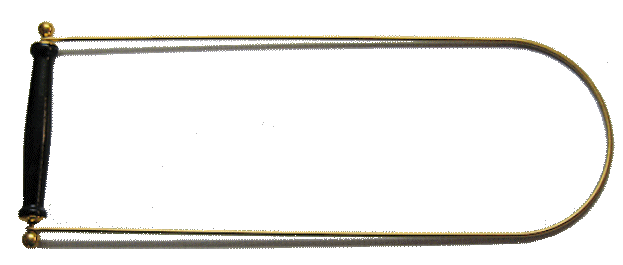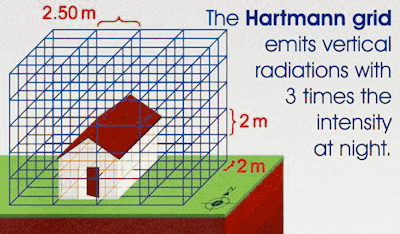The Cosmos Vertical Dowsing Rod or Swiss Dowsing Rod is often used by dowers to measure the Hartmann Grid and Curry Lines.

Geopathic stress is usually associated with underground water bodies and is implicated in causing health issues to people who are exposed to them for hours at a time. In order to determine the potential risk a field can cause, time is one of the most important factors to consider.
Besides time, there are other discovered grid lines that might combine and amplify Geopathic lines such as the Hartmann grid and Curry lines (both named after their discoverers).
Unlike Hartmann lines, Curry lines run diagonally to the Hartmann grid.

Associating it with the Earth’s magnetic field, The German physician Ernst Hartmann discovered it in 1954 and discussed it in his book Illness as a Location Problem, where he states, among other important facts, that Hartmann knots (places where horizontal and vertical grid lines cross) are risky places for a person to be since those places are where harmful radiation is intensified.
Hartmann lines measure around the earth running North-South and East-West and extend to a height of 60–600 ft. The North-South lines appear approximately every 6 feet 6 inches, while the East-West lines show every 8 feet 2 inches. Besides their location, Hartmann lines can change in size and strength depending on their geographical location.
Manfred Curry was an American doctor born in Munich in 1899. Although the Curry Lines are named after him, others claim Siegfried Wittmann discovered them in 1950.
The Curry lines are between 12 and 16 inches wide and spaced between 8 and 11.5 feet apart from each other. Like the Hartmann grid, the Curry Lines also form a global grid.
Experts point out that moon cycles influence the intensity of the Curry lines. For example, at the time of the full moon, these lines’ radiation is higher and more active, especially where they intersect with the Hartmann grid. Adding to this theory, Curry lines are stronger at night because of the moon’s action over them. Other experts suggest that these lines are stronger when they cross an underground waterway.
Apart from these grids, there is one more we should consider when trying to understand the world of radiation:
The Benker grid, named after Anton Benker and also known as the Benker Cubical System, is a spatial system of rows and columns 10-meters high, wide and deep. This theory states that each cube is electrically charged and the polarity changes from one cube to the next. Electromagnetic influences distort and amplify the intensity and spread of the Benker grid which, in turn, can influence exposed organisms.
Researchers suggest that the Benker grid, like the Curry lines, results from cosmic influences, whereas the Hartmann grid has to do with Earth energies.
Geopathic Zones have a range of influence from 2 to 200 feet and reach a height of 600 to 30,000 feet. Their direction is random and can be horizontal, vertical, or diagonal. When natural radiation rises through the earth, its wavelength becomes distorted. These distorted fields of radiation are harmful to live organisms by producing Geopathic zones. It is not uncommon to find them parallel to or imposed upon the Hartmann Grid.
Finally, Geopathic zones can be man-made. Examples of these are EMFs radiated from high tension or satellite towers, electrical street poles, or fuse boxes.
I haven’t personally used the Cosmos Vertical Dowsing Rod, and I can’t seem to find any information on the Internet or YouTube. However, I have used the C-Rod (Diagnostic) and the L-Rods when testing energetic fields.
Therefore, I can make simple and probably obvious suggestion on how to work with the rod, although I may miss more subtle features regarding this particular rod.

From my experience, when using either the L-Rod or the Diagnostic, when the lead ends come into contact with an energy border the rods will either turn as with the Diagnostic C-Rod or in the case of the L-rod, either cross or open depending on the mental programming applied.
Hold the Cosmos Vertical Dowsing Rod in one hand and walk until the rod swings left or right. I’ve also considered whether I can hold the rod downwards to take measurements, but I haven’t tried it.
One advantage of the Cosmos Vertical Dowsing Rod is it only requires one hand, whereas the L-Rod requires two. That’s not to say you always need to use two L-Rods when taking readings.
31 cm / 72 gm – (12.2″ / 2.54 oz.)
The L-Rod Dowsing Rod, the Bobber Pro, and the Aurameter can also be used to measure Hartmann and Curry Lines.
| Weight | .072 kg |
|---|---|
| Dimensions | 31 cm |
Reviews
There are no reviews yet.